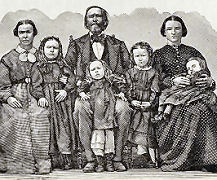

Home Page
The latest articles, features and news.


Read About...


Search Articles



Discussion Forums




|
| | |
|
28 February 2011
Polygamy delivers evolutionary hiccup for Mormons
by George Atkinson 
Evolutionary sexual selection went lop-sided in the 19th century thanks to the Mormon practice of taking multiple wives, say researchers in the journal Evolution and Human Behavior. Put another way, the more sister-wives a Mormon woman had, the fewer children she was likely to produce. "Although it's great in terms of number of children for successful males to have harems, for every new woman added to a male's household, the number each wife produced goes down by one child or so," said Indiana University evolutionary biologist Michael Wade. "This regression is known as a 'Bateman gradient,' named after the geneticist who first observed a similar phenomenon in fruit flies." The researchers' data covers nearly 186,000 Utah adults and their 630,000 children who lived or died between 1830 and 1894. This period marked an important transition for the Mormon Church, as polygamy began to be phased out in deference to U.S. laws banning the practice. The new study confirmed that ending polygamy would have the effect of decreasing the intensity of sexual selection among males and ultimately bringing the strength of reproductive selection on men closer to that acting on women. With fewer polygamous marriages, more males had access to wives, which led to a decrease in the variation in Mormon males' mating and reproductive success. The scientists estimate that ending polygamy reduced the strength of sexual selection on males by 58 percent. "Bateman's ideas still are very much alive, the present study included," Wade noted. "It was also his idea that selection could be stronger on males than on females, that what can be an advantage to males can be a disadvantage to females. And the advantage isn't just in having more mates. You may simply produce more offspring, than the average, if you're a male successful in reproductive competition against other males."
But, Wade says, polygamy is a bad thing for most males of a species. "When the ratio of sexes is about equal, for every male that has three mates, there must be two males that have none. If a male has even more mates, then the disparity among male 'reproductive' haves and have-nots can become quite great." So if polygamy is disadvantageous to most females and most males, why does it survive? "The complete answer is still forthcoming," Wade said. "One thing we know now... is that selection can be so strong on males that it can drag the entire species off of a naturally selected viability optimum. Take the peacock. Its tail is magnificent for attracting females and bad for attracting predators. Males trade high risks to their lives in order to gain large numbers of mates and thereby offspring." Related:
Attractiveness: The Evolutionary Aftermath
Evolution And The Penis
Fertility problems blamed on evolution
Dress For Reproductive Success
When women outnumber men, hemlines rise
Source: Indiana University
|
|





